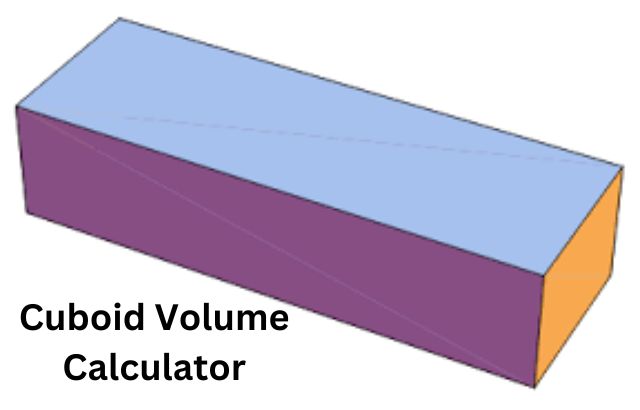Cuboid Volume Calculator | Find Total Cubic Feet’s
Articles, products, and services offered on this site are for informational purposes only. We are part of the Amazon Services LLC Associates Program, an affiliate advertising program. Amazon.com is compensated for sales resulting from links on our website.
Please review our disclaimer before acting based on anything you read or see.
The amount of space that a cuboid occupies is measured by its volume. A three-dimensional form with length, width, and height is the cuboid. If we start with a rectangular sheet and keep stacking them, we will eventually have a form with a certain length, width, and height. This stack of sheets resembles a cuboid, a form with 6 faces, 12 edges, and 8 vertices. This may be complex to find. Thus, we have made this post on Cuboid Volume Calculator to aid you.
Cuboid’s volume is expressed as the (unit)3. The United States Customary System (USCS) uses cubic inches or cubic feet to measure volume, while the standard unit uses cubic meters or cubic centimeters. Because the cuboid’s volume relies on its length, width, and height, altering any of those measurements alters the volume of the form. And with the Cuboid Volume Calculator, you can calculate this easily. Come along as we highlight more on this below.
Cuboid Volume Calculator
What is Cuboid Volume?
The entire amount of space filled by a cuboid in three dimensions is known as its volume. A three-dimensional object with six rectangular faces is called a cuboid. These six cuboid faces are two pairs of three parallel faces. As a result, the volume is a measurement based on these faces’ length, breadth, and height. Cubic units are used to measure it. The entire area that a cuboid’s rectangular faces cover is known as its surface area.
How to Calculate Cuboid Volume
The area taken up by a cuboid’s dimensions within the cuboid is known as its volume. The length, breadth, and height are the three dimensions. We refer to a cuboid as a cube when the area of its faces is the same. Because they are all squares, a cube’s faces all have the same area.
Consider a situation where we must figure out how much sugar can fit within a cuboidal box. In other words, our goal is to determine the box’s volume. The volume of a cuboidal box is essentially equal to its capacity. Thus, using the following formula, we can easily get the volume of the cuboidal box if we understand its length, width, and height:
Cuboidal box volume equals length, width, and height
To calculate the volume of any cuboidal form, follow these steps:
- Verify the cuboid’s measurements, including its length, breadth, and height.
- Verify that all measurements are expressed in the same units. If not, we must translate them into the same units.
- Multiply the length, breadth, and height together once all measurements have the same units.
- The volume of cuboids, expressed in cubic units, is the value acquired.
What is meant by the Volume of the Cuboid?
A cuboid is a three-dimensional form with 6 faces, 12 edges, and 8 vertices in geometry. The cuboid in three dimensions represents the rectangle in two dimensions. The cuboid is created when a rectangle is rotated around its axis. The rectangular prism is another name for the cuboid. The area that a cuboid form occupies is known as its volume. A cuboid formula’s volume is determined by,
A cuboid’s volume is equal to its length, width, and height in cubic units.
The space taken up by a cuboid’s walls in a three-dimensional space is another way to quantify a cuboid’s volume. Cubic measurements for this include m3, cm3, etc.
Frequently Asked Questions
How do you work out the volume of a cuboid without the height?
Assuming the cuboid has dimensions of 9, 8, and 360 cubic inches, respectively.
The cuboid volume formula yields:
Volume = l w h cube units.
Make h the scheme’s subject:
Volume/ (l w) cubic units, where h
Replace the specified values with:
h = 360/ (9 × 8) in3
Figure out the equation:
h = 6 in3
As a result, length and width would no longer be the standard phrase. Therefore, a cuboid’s height equals the product of its volume and base area.
What is the area and volume of the cuboid?
A cuboid’s total surface area is the summation of its surfaces. A cuboid’s total surface area may be calculated by adding the areas of each of its six rectangular sides. The formula for a cuboid’s total surface area is 2 (LW+ wh + LH), where l stands for the cuboid’s length, w for width, and h for height.
The sum of the cuboid’s length, breadth, and height.
Length, width, and height equal a cuboid (cubic units)
How do you calculate cube and cuboid?
Depending on their interfacial area, lateral surface areas, and volumes, cube and cuboid formulae are established. The table below illustrates this.
What is the formula for the volume of the cube?
Volume = a3, where an is the dimension of the cube’s sides or edges, is the equation for the cube’s volume.
How do you calculate volume?
The fundamental formula for volume is length, breadth, and height, as opposed to length, width, and height for the area of a rectangular shape. The computation is unaffected by how you refer to the various dimensions; for instance, you may use “depth” instead of “height.”
How do you calculate volume capacity?
The following steps may be used to determine volume capacity:
Change the measurements’ units to centimeters.
Before figuring out the volume, convert each component to centimeters (cm) if the measurements are supplied in meters, inches, feet, or any other unit of measurement. This will make converting to liters simpler.
Determine the shape’s volume.
The volume of each sort of form is calculated differently. Thus how you determine, the volume will rely on the geometry of the three-dimensional entity you are measuring. You may use the fundamental formula to get a cube’s volume. A three-dimensional shape’s volume will also be expressed in cubic units like cubic centimeters.
Transform a cubic centimeter into a liter.
Use conversion rate to do this. You may calculate the volume in liters by dividing the shape’s volume by 1,000. (L).
Expert Opinion
In general, the capacity of a cuboid is equal to the area it takes up in space. It depends upon the cuboid’s three dimensions, length, width, and height. Since all of a cuboid’s faces are rectangular, the phrase “Solid Rectangle” is also referred to as a cuboid. All of the angles and the opposing faces of a cuboid in a rectangular cuboid are at right angles.
The amount used to measure the inside space of a cuboid is its volume. A cuboid is a common three-dimensional form that surrounds us. The word “volume” describes how much of that shape may be contained based on a form’s parameters, such as length, width, and height.
A formula particular to a cuboid’s shape will be used to determine the volume of a cuboid. And if you need more ease here, the Cuboid Volume Calculator will aid you greatly.



Comments are closed.